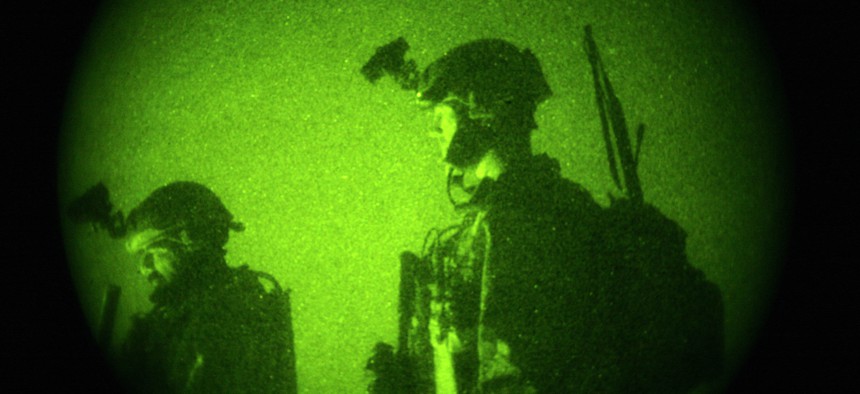
Thursday, Oct. 29, 2009 file photo taken with a night vision scope, U.S. Special Operations forces engage in a joint operation with Afghan National Army soldiers. AP / MAYA ALLERUZO
Nanotech Breakthrough Could Revolutionize Night Vision
Researchers build “teeny, tiny structures” that can change infrared to visible light.
Remember that famous Bin Laden raid? It would have been impossible without night vision — specifically, a pair of $65,000 L-3 Ground Panoramic Night Vision Goggles . But even those top-of-the-line NVGs — former Navy SEAL Matt Bissonette compared other night-vision systems to “looking through toilet paper tubes” — are heavy, clunky, and odd-looking. Now researchers from Australia have developed a material that can make infrared light visible, raising the possibility of night-vision goggles as thin as glass and free of external power.
Conventional night vision goggles look a bit like binoculars and require electricity. Here’s how they work: An “objective lens” in front collects low-level and near-infrared light, whose photons are converted by a photocathode into electrons. The goggles use thousands of volts of electricity to send the electrons down a vacuum-sealed tube into a plate with millions of tiny holes. Pushing the electrons through the holes releases other electrons in a chain reaction called cascaded secondary emission. The effect: where there was one electron, there are now hundreds, all in the same pattern as the original photons. When the electrons hit the final layer, which is covered in phosphorescent material, what was dark becomes light.
The team from Australian National University created aluminum gallium arsenide “nano-antennas” that essentially do the same thing, but far more simply, without vacuum tubes. The antennas, which are 500 times narrower than a human hair, pick up photons in the infrared range, combine with other photons (in the case of the experiment, emanating from a laser), in a way that increases the frequency and, thus, divides the wavelength, a process called second-harmonic generation.
“We managed to fabricate very teeny, tiny structures. Those magic structures are capable [of] changing the intensity of the light, change the shape of the light, and, at the same time, change the color of the light,” Mohsen Rahmani explained excitedly, in a video put out by ANU. “Our eyes are capable only of seeing light in the visible spectrum. If we can fabricate an area of nanostructures on flat surfaces like glass, at the end of the day we will be able to convert invisible light in the nighttime or dark areas into visible light.”
"Our device converts photons from infrared to visible light directly, without conversion into an electronic signal and then multiplied by an electron multiplier, as in the current, bulky devices. However, it would still require power to generate the laser light needed to amplify the image. I believe this will still be battery powered, but [the design] will significantly reduce the form factor to a very thin film," researcher Dragomir Neshev told Defense One.
"The hard bit is the design. The fabrication is challenging but to a some extent similar to the fabrication of high-performance soar cells for space deployment. The AlGaAs material is fairly abundant and is currently also used for high speed electronic devices and is in every mobile phone," said Neshev.
The researchers say that they have submitted a proposal to the Defense Advanced Research Projects Agency, or DARPA, to complete research into a version of the technology that could be inserted into glasses frames. DARPA declined to confirm or deny discussions were taking place, citing agency policy. In September 2014, DARPA put out a call for “compact, lightweight, heads-up, broad-band night vision display system for ground soldiers featuring cross-band infrared sensing and illumination for robust all-condition viewing.”




